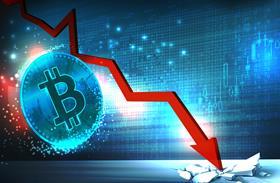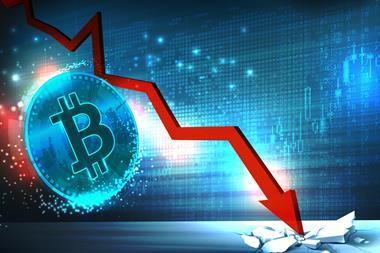’The downturn in the crypto markets signals a period of heightened caution and strategic reassessment’, says chief operating officer
The global stock market fell sharply during the first week of August 2024 – this impacted the cryptocurrency market, with the values of top currencies like Bitcoin and Ethereum plummeting as investors hurried to sell assets.

However, this is not the first decline to hit cryptocurrencies this year.
In May 2024, the market experienced a sharp drop in value from $2.51tn (£1.97tn) to $1.95trn (£1.53tn), which created a “ripple effect” for insurtechs that rely on the stability of cryptocurrency, according to Lynda Clarke, chief operating officer at fintech Tribe Payments.
For Clarke, the two markets are interconnected, so any turbulence in the cryptocurrency arena could be “particularly challenging for insurtechs as it tightens capital availability and increases investor scrutiny”.
She told Insurance Times: “The downturn in the crypto markets signals a period of heightened caution and strategic reassessment.
”This could impact [firms’] ability to fund new tech [propositions] and scale operations, especially for those heavily reliant on cryptocurrency or blockchain technologies.”
She added that when budgets or investments are tightened, one of the first business areas to be impacted is often research and development or “innovation” because this does ”not provide an immediate return”.
But what exactly is the impact on insurtech?
Trough of disillusionment
One field that insurtech has been keenly investing in is artificial intelligence (AI) – this could therefore be a key area of innovation impacted by tech stocks declining and investment capital shrinking.
Emily Taylor, chief executive at Oxford Information Labs, noted that the “AI bubble could be bursting” in line with cryptocurrency’s crash.
Read: Briefing – Could R&D tax credit error and fraud be the next PPI scandal?
Read: Majority of UK insurance executives investing in AI and machine learning
Explore more insurtech-related stories here, or discover more news analysis here
Referring to the Gartner hype cycle methodology, Taylor explained: “We’ve passed the peak of inflated expectations and are heading towards the trough of disillusionment.”
The Gartner hype cycle is a framework used to assess the maturity and potential of emerging technologies. It includes five phases – technology trigger, peak of inflated expectations, trough of disillusionment, slope of enlightenment and plateau of productivity.
The trough of disillusionment is when interest in the technology being tested wanes as experiments fail to deliver. Therefore, investment in the technology only continues if providers are able to improve associated products to satisfy early adopters.
Ed Halsey, vice-president of marketing at Genasys, agreed that “AI is now headed towards the trough of disillusionment”.
He explained: “Many have tried to force AI strategies within their businesses, leading to speculative use cases that have failed to deliver. Instead, [firms] should consider AI as part of their ongoing tool kit – priorities for businesses should not suddenly change [because] of AI.
“Many have been guilty of trying to find problems to point at AI solutions – this is back to front and inevitably leads to poor returns. In turn, that leads people to declare that AI isn’t all it is hyped up to be when the reality is [that companies] have tried to force its usage in the wrong areas.”
Despite strategic confusion around AI’s usage, Halsey believes that “AI will continue to gather pace and, [in] the medium term, it’ll undoubtedly change the world – both in people’s business and personal lives”.
He continued: “While the short-term outlook may see a period of doubt and disillusionment, long-term adoption feels inevitable at this point”.
Taylor agreed, calling AI ”a game-changing technology”.
Nigel Green, chief executive at DeVere Group, added that “companies deeply invested in AI have seen their stock values soar to unprecedented heights”, indicating that there is still appetite and interest in AI, a technology which he described as introducing ”profound and lasting changes” to businesses.
Green continued: “This explosive growth has led to concerns that the market is inflating beyond sustainable levels, reminiscent of the dot-com bubble of the late 1990s.”
Peaks and troughs
Musing on the trajectory of cryptocurrency stock, Halsey said: “With high risk, comes high rewards and many [in the market] are still hopeful of a 2024 bull run, with [cryptocurrency] analysts projecting a peak towards the end of this year.
”Of course, the returns that can be made are rapid and vast and there is far more flexibility to get in and out of [cryptocurrency] investments quickly [versus] investing into businesses.
”The fear and greed index currently sits at a midpoint – and we’ve seen most stable coins are down 10% to 30% on the 90-day charts.”
Clarke added that this is not the first time the crypto stock market has crashed and that she expected further fluctuations in the future – however, “the businesses that set themselves up to deal with these peaks and troughs” will be the ones that survive, she predicted.
Green, meanwhile, said that the crypto stock market price dip presents “opportunities for investors to capitalise on the long-term growth potential of AI, rather than [being viewed] as [a sign] of impending doom”.
Also on a more positive note, J Gdanski, chief executive of Lloyd’s-backed crypto insurance firm Evertas – which insures around 70% of the world’s top Bitcoin miners – said: “Despite short-term volatility, crypto’s historical upside has far outpaced that of any segment of the equities and commodities markets across several market cycles.”
Ultimately, there will be winners and losers arising from the crypto stock market crash – but how insurtech will fare is still up for debate.
- Insurance Times converted dollar amounts to pound sterling at a conversion rate of £1 = $1.28, as at August 2024.












































No comments yet